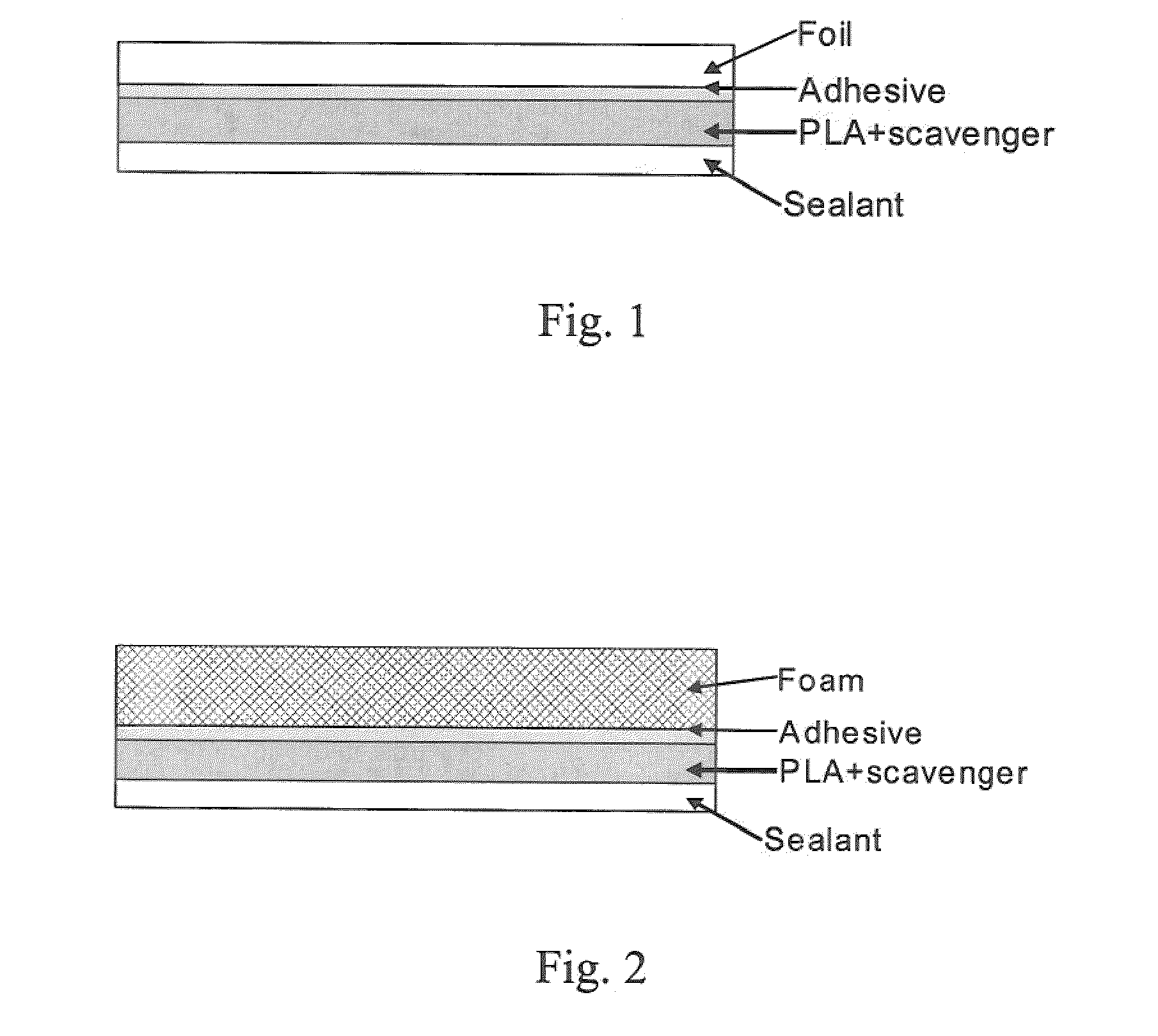Biodegradable polymer articles containing oxygen scavenger
a biodegradable polymer and oxygen scavenger technology, applied in the field of oxygen scavengers, can solve the problems of deterioration of wall transparency and mechanical properties, less useful packaging products, processing difficulties,
- Summary
- Abstract
- Description
- Claims
- Application Information
AI Technical Summary
Benefits of technology
Problems solved by technology
Method used
Image
Examples
example 1
Extrusion of PLA Films Containing Iron as Oxygen Scavenger
NatureWorks PLA2002D resin, poylactic acid, was dried in a desiccant oven at 60 C for 4 hrs. Iron, NaCl and NaHSO4 were mixed with a weight ratio of Fe / NaCl / NaHSO4=85 / 3 / 12 by following the procedure described in U.S. Pat. No. 6,899,822, US Pat. applications 2005 / 0205841 and 2007 / 020456 to form FB. The mixture, FreshBlend (FB), was blended with the PLA resin with various ratios and extruded in a twin screw extruder at an average extruder and die temperature of 220 C. The extruded film was collected by using a winder to make films of 5″ wide and approximately 4 mil thick. The extruded films were used for oxygen scavenging test. The films were stored in a 7″×7″ plastic barrier bags with the enclosure of wet felt papers as moisture source. The bags were sealed and injected with 350 or 150 cc of O2 / N2 mixture to achieve a starting oxygen concentration of approximately 1%. The oxygen concentration inside the bags was measured by MO...
example 2
PLA Laminates Containing Oxygen Scavenger
FIG. 2 shows a laminate in accordance with this invention. The 6% FB loaded PLA film made in Example 1 was used for lamination to foil. Dow Integral™ 801 film was used as adhesive to make a three layer laminates of the structure of Foil / Integral 801 / (FB+PLA) with the thicknesses of 1 / 1 / 4 mil respectively. The three layers were heat laminated in a heat seal laminator at approximately 180° C. The laminates were formed with good bonding between the layers. The laminates were sealed in a barrier bag with 0.93 water activity moisture regulator. The oxygen scavenging behavior namely the decrease of oxygen concentration with time for FB / PLA films and laminates is shown in Figure-1 with 150 cc O2 / N2 mixture and a starting concentration of 1.04% or 1.56 cc. The oxygen was depleted after 40 hours of storage. This demonstrated that the oxygen scavenging capability of the laminated structure containing FB and PLA.
example 3
Coextrusion of PLA Films
The same materials were used for coextrusion of PLA in a 5-layer film structure by using a film coextrusion system. The 5 layer was arranged as A / B / C / B / A=LDPE / tie / (PLA+FB) / tie / LDPE in approximately 5 / 5 / 80 / 5 / 5 thickness ratio. The Freshblend net content was 5 wt % distributed in the C layer only. Extrusion was conducted at an average extruder exit temperatures of A=500F, B=500F and C=390F. The LDPE resin was Dow LDPE640I. The tie layer resin was Admer QF551A, maleic anhydride modified polypropylene, and PLA was NatureWorks 2002D resin. By properly adjusting the extrusion rates and the die temperature, 3 and 3.5 mil thin films were produced that consists of the five layer structure. The PLA layer that contains Freshblend was estimated in the range of 2-3 mil. This demonstrated the processability of PLA with the iron-based oxygen scavenger to form thin films in multilayer structure.
PUM
| Property | Measurement | Unit |
|---|---|---|
| Fraction | aaaaa | aaaaa |
| Particle size | aaaaa | aaaaa |
| Particle size | aaaaa | aaaaa |
Abstract
Description
Claims
Application Information
 Login to View More
Login to View More - R&D
- Intellectual Property
- Life Sciences
- Materials
- Tech Scout
- Unparalleled Data Quality
- Higher Quality Content
- 60% Fewer Hallucinations
Browse by: Latest US Patents, China's latest patents, Technical Efficacy Thesaurus, Application Domain, Technology Topic, Popular Technical Reports.
© 2025 PatSnap. All rights reserved.Legal|Privacy policy|Modern Slavery Act Transparency Statement|Sitemap|About US| Contact US: help@patsnap.com



